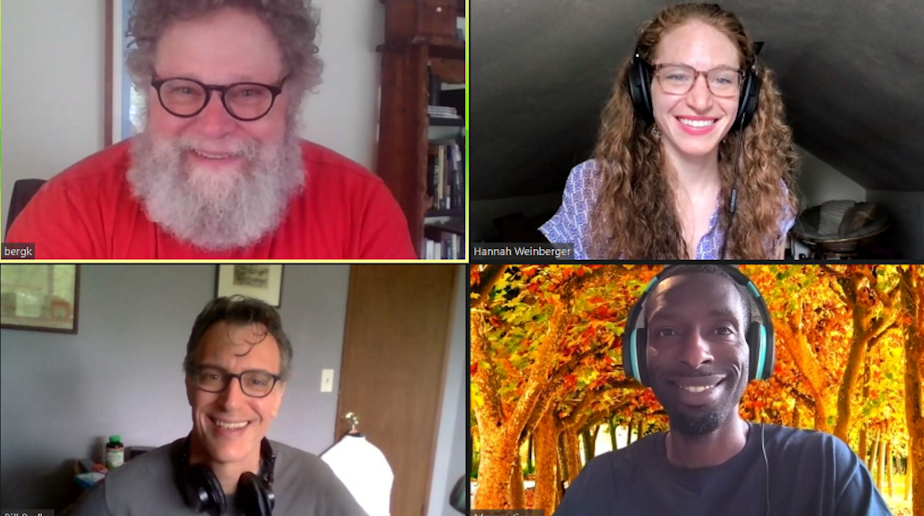UFOs, gray wolves, and restorative justice, this week

Bill Radke reviews the week’s news with Crosscut reporter Hannah Weinburger, South Seattle Emerald publisher and Seattle Times columnist Marcus Harrison Green, and Crosscut's Editor-at-Large Knute Berger.
This week, an overwhelming heat dome baked much of the American West with unprecedented temperatures. Areas of the Pacific Northwest recorded temperatures hotter than Phoenix and Las Vegas (i.e., the literal desert), and the heat had devastating effects on cities which have largely escaped the need for air conditioning -- cities like Seattle, which is the least air conditioned top 15 metro area in the country. As of Wednesday evening, Washington state emergency rooms saw 1,648 visits for suspected heat-related illness since the start of Friday’s broiling temperatures. 22 percent of those who arrived ended up being admitted. The state also saw 35 drownings during that same period as residents flocked to lakes and beaches to stay cool. What should the state and region have done to prepare for this heatwave?
Speaking of a once in millenia heat, July 4th is just around the corner -- and that means fireworks. With wildfires already starting in BC and California, concern that one of America’s most explosive forms of celebration could scorch even more of our already scarred countryside has prompted localities along the west coast to ban the use of fireworks this independence day. But banning the use of fireworks is different from banning the sale of fireworks, which is still going strong in “Firecracker Alley” outside of Tacoma. Because the Alley is on sovereign Puyallup land, the sale of fireworks goes on despite outside ban, and the sale of fireworks has helped families stay afloat as other industries dry up. Should fireworks really still be part of the way we celebrate, considering how terrible they are for safety and the environment?
As the heat broke on Wednesday, Washington officially reopened - Governor Inslee even caught a fish at Pike Place to prove it. That means restrictions have been lifted on pretty much everything: capacity for meeting spaces like restaurants or churches, who can sit at a bar or what distance you have to keep at restaurants, plus vaccinated people can stop social distancing and wearing masks both indoors and outdoors. But there are still concerns. The Covid Delta variant is one of the three most predominant Covid strains in Washington right now, and represents about 17% of cases in the state. Other countries have reinstituted masking requirements as a result of this strain. Washington officials say that as of now there are no plans to re-institute a mask policy. So what does reopening actually look like right now?
Also - It’s a commonly known fact that the United States has one of the highest percentages of an incarcerated population in the world. In fact, even as crime drops year after year across the country to historic lows, the US’ incarceration rate remains incredibly high. One prevailing reason is the widely held belief that incarceration is a form of retribution more than it is rehabilitation. Locally, the stories of Devon Adams and Yonas Seifu show how difficult it can be to actually heal from the trauma of violence and incarceration in America. Seifu sustained life-changing injuries when a stray bullet struck in the head at a University of Washington fraternity party. Adams served 22 years in Washington state prisons after killing Franklin Brown in an escalated argument. Both have since joined groups seeking to shift the assumption that incarceration should be the default solution to crime, instead focusing on collective healing between perpetrator and victim, with an emphasis on asking why crime happens instead of simply believing that “bad people do bad things.” Are prisons even meant to help victims find peace?
Plus, there are at least 178 wolves in Washington right now. And just that small number has taken a lot of work. Wolves were exterminated from most of the US by the 1930s, and only made a comeback in the West after being reintroduced in 1995. This May one of those wolves was illegally killed. The Washington Department of Fish and Wildlife says the wolf is believed to be the breeding female of a pack, and just had pups earlier this year. Now the WDFW is offering a $7500 reward for information on who poached the animal. Since 2010, 12 wolves have been poached in Washington. Why do people want to poach wolves, and what impact does it have?
Sponsored
Finally, last week the US Government released a report on unidentified flying objects. They cited 140 examples, at least 20 moving in ways or at speeds unlike any known technology. UFO sightings have a storied history in Washington - starting with a sighting by pilot Kenneth Arnold back in 1947, who reported seeing shiny objects by Mount Rainier. That report began a media frenzy. And during the same week came the announcement of a hominid discovery in China, based on a newly studied skull originally found in the 1930s. The New York Times reports that the skull belonged to a “mature male who had a huge brain, massive brow ridges, deep set eyes and a bulbous nose.” To some, that might sound a lot like one of Washington’s best known cryptids - the Sasquatch. Is there something specific to Washington that gets people interested in these phenomena?






